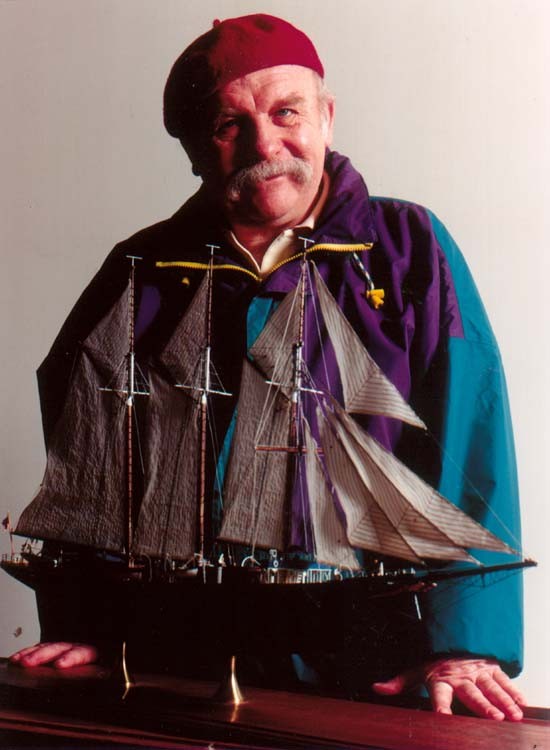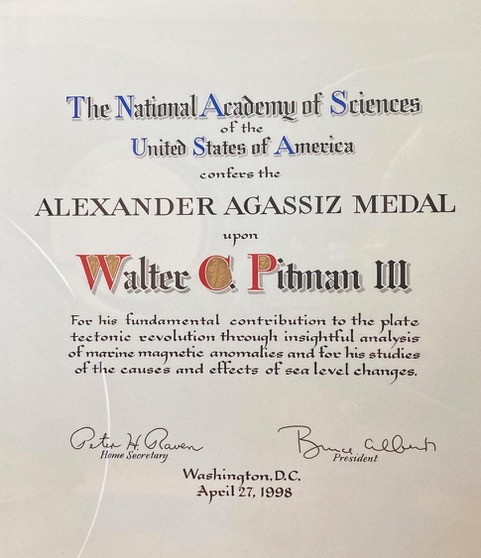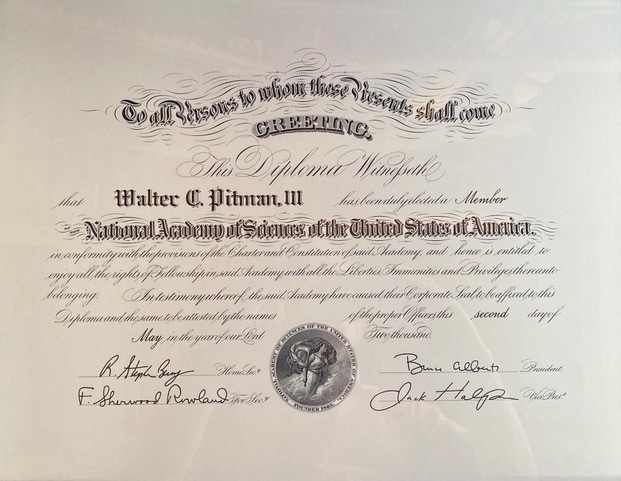Walter Pitman: Discoverer of the key to the Plate Tectonics Paradigm
Walter C. Pitman III, renowned for his discovery of magnetic anomalies aligned symmetrically about the axis of the mid-ocean ridge, leading to the conversion of all but diehard skeptics to the hypotheses of seafloor spreading, continental drift and plate tectonics, died October 1 at the age of 87. He spent his entire scientific career at the Lamont-Doherty Earth Observatory of Columbia University. For several decades he taught Plate Tectonics in the University’s Department of Earth and Environmental Sciences. While still a graduate student, Walter was Chief Scientist aboard the research vessel Eltanin in 1965 collecting bathymetric and magnetic measurements across the Pacific-Antarctic Ridge. His analysis of four transects across the ridge, extending to 500 kilometers on each side of the ridge crest, revealed a pattern of weak and strong magnetization of the oceanic crust parallel to the ridge center that was astonishingly symmetric. Using the known reversals of the geomagnetic field during the past 3.4 million years, Walter and his thesis advisor, James Heirtzler, unraveled the history of past geomagnetic reversals back to ten million years. Soon afterwards, with the discovery of older. magnetic stripes in the western Pacific, he and colleagues took the reversal history all the way to 165 million years. The paleomagnetic timescale based on marine magnetic anomalies became a fundamental tool in stratigraphy. The Eltanin 19 magnetic anomaly profile is legendary and has appeared countless times in scientific publications and textbooks.

In 1972 Walter and Manik Talwani used the pattern of magnetic anomalies and the evolving paleomagnetic timescale to unravel for the first time the history of the opening of the North Atlantic, which they described in terms of a sequence of Euler poles and angles of rotation for the independent separations of Africa and Europe from North America. The computed relative motions of Africa with respect to Europe were used by Walter and John Dewey to calculate the closure of the Tethyan Sea and the evolution of the Alpine chain mountain belts extending from the Pyrenees to the Zagros in Iran. The disappearance of Tethys did not involve subduction along a single, simple plate boundary between Europe and Africa (as had been envisioned previously), but, instead, by a constantly evolving mosaic of subsiding continental margins, migrating mid-oceanic ridges, transform faults, trenches, island arcs, and marginal seas they called back-arc basins.
In 1974 Walter coordinated the assembly of a global map showing the ages of all the ocean basins and the trajectories of the continents over eons. “I didn’t imagine ever being involved in something so astonishing and so very, very important at such a young age,” he said. “A whole bunch of us were working on it together, and together we accomplished a lot in just a few years.”
In a publication with James Hays, Walter showed that the rapid pulse of seafloor spreading between 110 and 85 million years ago would account for the world-wide Mid to Upper Cretaceous transgression that flooded the interior of continents- producing many of the se. Rapid spreading caused the mid-ocean ridges to expand and hence reduce the average depth of the ocean basins.
Following his new interest in sea level, Walter went on to explore the relationship between eustacy and stratigraphic sequences of passive margins, which earned him the Francis Shepard Medal from the Society for Sedimentary Geology. Although it had been commonly thought that transgressive or regressive events occurred simultaneously on geographically dispersed continental margins as the result of worldwide sea-level rise or fall, Walter showed that such events are caused by changes in the rates of sea-level rise or fall because margins subside around a hinge line. “The shoreline will seek that point on the subsiding margin at which the rate of sea-level fall is equal to the rate of subsidence minus the sedimentation rate.” Walter’s original insight provided a quantitative approach to the emerging discipline of sequence stratigraphy.
Receiving an invitation from the Shirshov Institute of Oceanology of the Russian Academy of Sciences, he ventured into the Black Sea with new technology to image seascapes buried under a thick cover of sediment. Along with expedition leader, Kazimieras Shimkus and Columbia colleague, William Ryan, he discovered not only ancient shorelines as deep as 140 meters, but meandering rivers and coastal dunes belonging to the margins of a vast freshwater lake dating back to early post-glacial time. The lake vanished suddenly when flooded by saltwater pouring through the Bosporus Strait. The evidence of the massive deluge was published in 1998 in Noah's Flood: The New Scientific Discoveries about the Event that Changed History.

Walter was a fellow of both the Geological Society of America and the American Geophysical Union, which awarded him its Maurice Ewing Medal in 1996. In 1998, he received the Alexander Agassiz Medal of the United States National Academy of Sciences "for his fundamental contribution to the plate tectonic revolution through insightful analysis of marine magnetic anomalies and for his studies of the causes and effects of sea-level changes" and in 2004 he was elected as a member of that academy. He was honored in 2000 with the Vetlesen Prize for plate tectonic theory, theoretical geomorphology and tectonics. And in 2013, he was elected fellow of the American Association for the Advancement of Science. The large offset of the Pacific-Antarctic Ridge that Walter discovered aboard the Eltanin in 1965 has been named the Pitman Fracture Zone.

Walter was admired by his students and colleagues as a great synthetic scientist who wove a cloth of understanding about the earth from sets of diverse observations and methodical calculations. One of Walter’s charming characteristics was an inability to take himself seriously. Conversations with Walter were peppered with humor and stories of his experiences in science and in life. He interrupted his classroom lectures with sea tales, including a narrow escape in 1961 aboard Lamont’s research vessel Vema through Neptune’s Bellows Strait in Deception Island, Antarctica, as the narrow passageway was almost filled for the duration of the southern hemisphere winter by a sudden rush of wind-blown ice.
Walter earned his first degree in Electrical Engineering at Lehigh University. He went to work at the Haseltine corporation, but found his responsibilities too tedious to be worth his time. Seeking adventure, he made his way to the Lamont Geological Observatory, where his engineering skills were recognized and valued. He sailed on the Vema for nearly a year before returning to Lamont to begin graduate school at Columbia.
Walter’s marriage to the former Virginia Piser ended in divorce; he never remarried. His Upper West Side New York apartment served as a hotel for former students and international friends passing through town. He will be remembered for his scientific contributions and held dear in the hearts of those who were privileged to work with him or know him. He is survived by his brother Donald Pitman; two daughters, Amanda Pitman and Cordelia Pitman; and two grandchildren.

